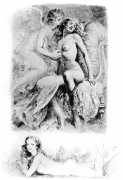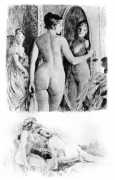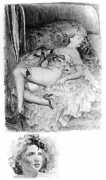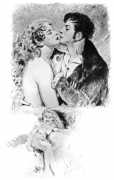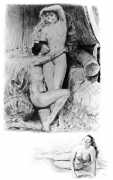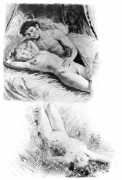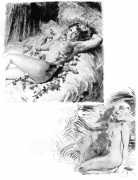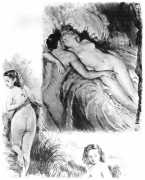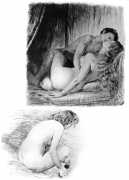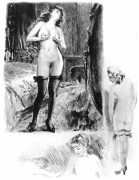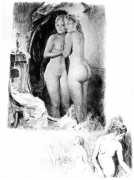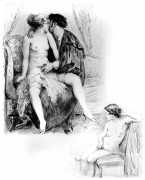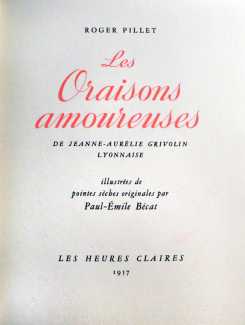 ‘My beautiful one, my love, my pet; you can teach me the religion of love! I the great lover, you the distant young love of my life – I am prepared to die in the beauty and ardour of your kiss!’ The eighteen-year-old Jeanne-Aurélie Grivolin, on holiday in Cherbourg, reads a letter from her older Parisian lover and believes every word. Except that neither the lover nor Mademoiselle Grivolin actually exist beyond the imagination of a schoolteacher from Lyons, Roger Pillet (1886–1918), who wrote Les oraisons amoureuse shortly before his early death. It was first published by Lyons publisher Deux-Collines in 1919 with illustrations by Pillet’s friend Pierre Combet-Descombes, and as well as the fantasy love-letters included a short ‘biography’ of Jeanne-Aurélie Grivolin, even giving her dates as 1784–1869.
‘My beautiful one, my love, my pet; you can teach me the religion of love! I the great lover, you the distant young love of my life – I am prepared to die in the beauty and ardour of your kiss!’ The eighteen-year-old Jeanne-Aurélie Grivolin, on holiday in Cherbourg, reads a letter from her older Parisian lover and believes every word. Except that neither the lover nor Mademoiselle Grivolin actually exist beyond the imagination of a schoolteacher from Lyons, Roger Pillet (1886–1918), who wrote Les oraisons amoureuse shortly before his early death. It was first published by Lyons publisher Deux-Collines in 1919 with illustrations by Pillet’s friend Pierre Combet-Descombes, and as well as the fantasy love-letters included a short ‘biography’ of Jeanne-Aurélie Grivolin, even giving her dates as 1784–1869.
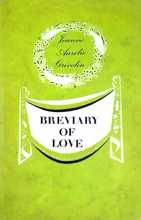 And the book with its invented saccharine love-letters might well have disappeared from view, except that publishers kept eyeing the text with its excellent lover-to-lover gift potential, especially when suitably illustrated. René-Louis Doyon’s publishing house La Connaissance produced a limited edition illustrated by Yan Bernard Dyl in 1926, and when the large Paris publisher Denoël reprinted it in 1938 they also sold the English-language rights to Constable; when he discovered it James Bond author Ian Fleming gave an inscribed copy to his ‘secret’ lover Maud Russell. Constable translated Oraisons as Breviary of Love; being the private journal written at Lyon and Cherbourg during the years 1802–3 of Jeanne Aurélie Grivolin; the (good) translation was by Michael Sadler.
And the book with its invented saccharine love-letters might well have disappeared from view, except that publishers kept eyeing the text with its excellent lover-to-lover gift potential, especially when suitably illustrated. René-Louis Doyon’s publishing house La Connaissance produced a limited edition illustrated by Yan Bernard Dyl in 1926, and when the large Paris publisher Denoël reprinted it in 1938 they also sold the English-language rights to Constable; when he discovered it James Bond author Ian Fleming gave an inscribed copy to his ‘secret’ lover Maud Russell. Constable translated Oraisons as Breviary of Love; being the private journal written at Lyon and Cherbourg during the years 1802–3 of Jeanne Aurélie Grivolin; the (good) translation was by Michael Sadler.
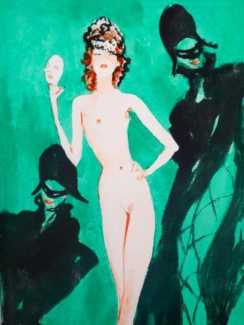
That was not the end of the Oraisons, however. In 1951 Collection du Lierre produced a new limited edition with ten very-1950s colour illustrations by Jean-Gabriel Domergue, and in 1957 the high-quality art publisher Les Heures Claires invited Bécat to produce a new portfolio to accompany Pillet’s colourful text. Bécat clearly enjoyed the commission, and freed from the constraints of a tight narrative produced some of his best and most mature work; it was to be one of the last books he illustrated.
The Bécat-illustrated Oraisons was published in a limited numbered edition of 650 copies, cased in a cream étui (slipcase).
We are very grateful to Talisman Fine Art (www.talismanfineart.com) for these illustrations.


